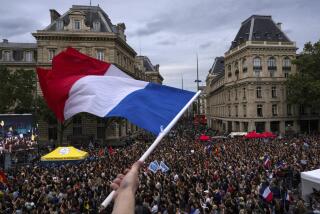Leaving Paris and a bit of her heart behind
- Share via
Paris -- The French may rail about Hollywood’s global domination, but they have a soft spot in their hearts for vintage American movies, as anyone who watches French television knows.
Channel surfing here has given me such pleasures as the 1949 John Ford western “She Wore a Yellow Ribbon,” which takes on a whole new dimension when the Duke is dubbed in French.
One night not long ago, I landed in the middle of the 1957 Fred Astaire and Audrey Hepburn musical “Funny Face,” set in the French capital, with songs by George Gershwin. When Astaire and company launched into the number “Bonjour, Paris,” I ran for a pen and jotted down this lyric: “All good Americans should come here to die.”
All good Francophiles understand that sentiment, but it took on special significance for me because, after three years in Paris, I’m about to leave. I’m headed for new horizons in Asia, firmly believing there’s life after the City of Light. But before I go, I wanted to share a few more secrets about Paris.
Every little girl or every woman about to go to Paris for the first time should see the movie “Funny Face.” It is the stuff of Parisian dreams.
In “Funny Face,” Hepburn stars as a beautiful beatnik -- she even does a quasi-Martha Graham modern dance number featured recently in a TV commercial for the Gap -- and Astaire plays a fashion photographer, based on Richard Avedon, who gets her to come to Paris as a magazine cover girl. Hepburn wears tiny black shirts and slacks when she philosophizes with French intellectuals in smoky cafes and dons Givenchy for the fashion shoots.
Critics said Astaire looked too old for Hepburn. Boy, did they not get it. May-September romance is a Paris specialty. If you want to see how hot it can be, consider the tryst scenes between old Uncle Edgar and the pretty young American Isabel in Diane Johnson’s novel “Le Divorce.” In the 2003 movie based on the book, French actor Thierry Lhermitte played Uncle Edgar; he was too sexy for words, just not old enough.
French is helpful; ph-h-h-t is more so. You can study at the Alliance Francaise or register for the Sorbonne’s Cours de Civilisation Francaise, a one-year program that has been attracting American students to the Latin Quarter since 1919. But unless you learn how to do what I call a French raspberry, you’ll never be able to communicate with authority in Paris.
I call it a raspberry for lack of a better word. It involves pursing the lips and emitting a puff of air, like the instrument used in glaucoma tests. A shrug of the shoulders generally goes with it.
What does it mean? “Obviously.” “You must be kidding.” “These vegetables are wilted.” “Why should I clean up after my dog?” There is no precise translation. It’s useful on almost any occasion, and the more you do it, the more French you feel.
It’s all a matter of taste, and some are just better here. We have shallots in America but don’t make full use of them. They are called echalotes here and seem to be bigger than the ones in the U.S. (Conversely, French onions seem smaller than the American version.)
But what to do with an echalote?
Although I didn’t learn how to make souffle or blanquette de veau during my time in France, I did figure out that echalotes are the secret ingredient of a perfect vinaigrette. Chop one fine, along with some fresh parsley. Add high-grade olive oil and ordinary wine vinegar (no fancy stuff, please) in 3-to-1 proportion. Then put in a teaspoon of prepared Dijon mustard. (I use Maille, a common brand here.) Whisk it, pour it on a salad and toss. If you can find sucrine lettuce, a sort of baby Romaine, nothing else is needed: Voila, a classic salade verte.
The French have their salad course after the main dish. But many of my French dinner guests politely reject salad plates, preferring to eat their greens on the same plate that held the main dish, to sop up leftover juices. It sounds gnarly but is delicious.
A new view can change your perspective. I have never been a big fan of Montmartre, the ersatz bohemian neighborhood surrounding the basilica of Sacre Coeur on the Right Bank. To me, it always seems crowded and touristy, a Hollywood studio version of Gay Paree.
But I have just discovered that it is a sort of New Year’s Day place of pilgrimage for the French.
They sleep late that morning, then climb the steps leading to the church and stand at the railing looking over the most beautiful city in the world. From there you can see all the great landmarks, from the Centre Pompidou to the Eiffel Tower. It’s a fine way to ring in the new year (or a new day) and work off a hangover.
Coffee makes the world go round. Drinking java is as Parisian as baguettes and berets, though tourists quickly learn that ordering coffee with milk, or cafe creme, after breakfast time is something of a faux pas. At all other times, Parisians tend to drink high-proof espresso in a demitasse, known as a petit cafe.
Moreover, cafe creme is usually pretty bad here. I know an American expat who sampled it all over the Left Bank and found the best at Les Deux Magots on the Boulevard St.-Germain, served in two pitchers, one for the coffee and the other for the warm milk. It costs about $10 if you order it with a croissant, which is why I eat breakfast at home.
For people like me who drink their coffee with milk, it’s useful to know that you can order it any time in Paris without getting a French raspberry if you ask for a noisette, which is a petit cafe with steamed milk.
At better places a petite cafe or a noisette comes with a little chocolate bonbon. But you can’t always count on it, which is one of the things my sister, who lives in Brussels, notices when she comes to visit me. In Brussels, no self-respecting cafe would serve caffeine without a treat.
Of course, this is not all I learned by moving to Paris. I found, above all, that it takes time to break the ice and to get things done in France. The Gallic people simply cannot be rushed and are sticklers for correct procedure.
When I first got here I had nothing but trouble with the clerks at my local post office. I put myself through contortions too extraordinary to explain in order to get a carte de sejour, a residence permit allowing me to stay in France for three years.
Having a carte de sejour helped me open a French bank account, and these days I’m never asked to show the permit when I go to the post office to pick up mail. One clerk wished me every good thing for the new year.
Knowing I was a foreigner, my neighborhood greengrocer consistently overcharged me at first. Now she throws extra apples and tomatoes in my bag.
I will miss these people and my handful of dear French and American expatriate friends. I will miss having my sister come to visit me in my ideal little Left Bank apartment.
I will miss my hairdresser, Frank, on the Rue du Pre aux Clercs, and the flower peddler on the Rue du Bac whose breath always smelled of alcohol. I will miss Monoprix, the Arlequin movie theater on the Rue des Rennes -- especially on Sunday mornings -- and the winter and summer sales at shops along the Boulevard St.-Germain.
Of course, the “Funny Face” City of Light that shaped my dreams as a little girl never existed.
Today, the underclass suburbs of Paris are at times in turmoil, France has increasingly yielded to more cutting-edge art and style centers, and its politics seem deeply confused.
Maybe travel is about seeing how dreams shape up. Nevermind “Funny Face.” When I was a child and people asked what I planned to be when I grew up, I always said I wanted to be Chinese. I don’t know what that was about, but I’m going to find out.
More to Read
Sign up for The Wild
We’ll help you find the best places to hike, bike and run, as well as the perfect silent spots for meditation and yoga.
You may occasionally receive promotional content from the Los Angeles Times.






